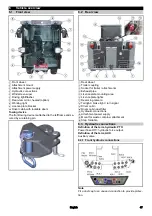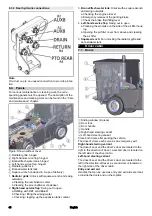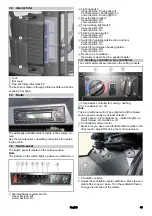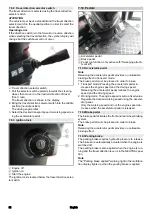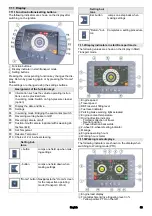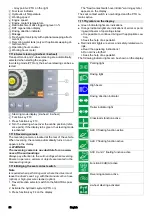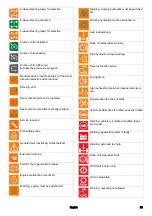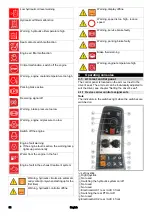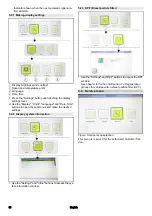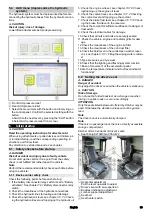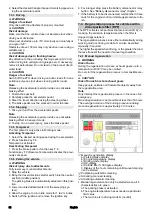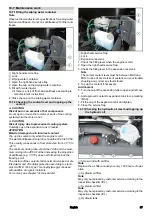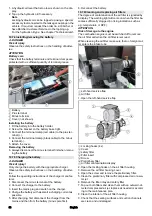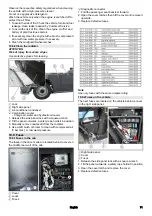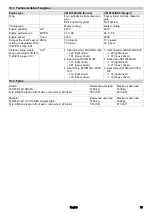
English
61
6.4.1 Refuelling
DANGER
Risk of explosion
Do not refuel in confined spaces.
Do not smoke and avoid open flames.
Ensure that no fuel gets on hot surfaces.
몇
CAUTION
Risk of injury
Note the risk of slipping due to spilt fuel.
ATTENTION
Fuel expands when heated, do not fill up to the brim.
1. Switch off the ignition.
2. Open the tank cap.
3. Fill with fuel.
Only diesel fuel according to DIN EN 590 may be used.
4. Wipe of any spilt fuel and close the tank cap.
6.4.2 Fill DEF or AdBlue®
DEF (Diesel Exhaust Fluid) is manufactured in compliance
with strict quality standards. Only use a fluid that complies
with ISO 22241 standards.
ATTENTION
It is prohibited to use urea solutions whose properties
differ from those specified.
ATTENTION
Where possible, do not partially fill the tank with par-
tial quantities otherwise a warning light is displayed. If
this warning light comes on you cannot reset it, but it
goes out after several refuelling operations. This does
not affect the functionality.
Only refuel when the filling level of the DEF container is
well below 50% (shown in the display).
1. Open the right-hand service flap.
2. Open the blue DEF reservoir cap.
3. Add DEF, do not overfill.
Rinse off excess DEF with plenty of water.
4. Close the reservoir cap and right-hand service flap.
7
Operation
DANGER
Risk of crushing
Make sure that there no persons are in the vicinity of the
vehicle during operation.
When using the vehicle as a tractor, make sure that there
are no persons between the vehicle and the trailer during
operation.
몇
CAUTION
Risk of burns
Only use the vehicle if all panels are attached.
ATTENTION
Risk of damage due to overheated hydraulic oil or
overheated engine
If the hydraulic oil temperature is too high or the coolant
temperature is too high, run the engine at idling speed until
the temperature drops below the "warning lamp off" trigger
value.
ATTENTION
Risk of damage due to lack of lubrication
If the "Engine oil pressure" warning light comes on during
operation, immediately move the vehicle out of the hazard
zone of the flowing traffic and switch off the engine. Then
have the fault fixed.
몇
CAUTION
Reduced stability due to attachments
Adjust the driving style.
7.1
During the first 10/50/100 operating hours
(running-in period)
●
Drive the first 100 hours of operation gently and avoid
overloading.
●
After 50 operating hours: Initial inspection must be car-
ried out by the authorized Customer Service according
to the inspection checklist (ICL).
●
After 10 operating hours: Check the wheel bolts.
7.2
Parking brake
The parking brake requires hydraulic pressure to release.
The brakes are automatically actuated when the engine is
switched off.
The parking brake is also applied when the engine is run-
ning and the travel direction lever is in the NEUTRAL posi-
tion.
Note
The "Parking brake applied" warning light in the multifunc-
tion display lights up when the parking brake is applied.
7.3
Drive mode
7.3.1 Start the engine
1. Sit in the driver's seat.
2. Insert the ignition key in the ignition lock.
3. Bring the travel direction selector switch into the middle
position (neutral position).
4. Switch on the ignition.
5. Wait until the display is complete.
6. Start the motor.
If the charge indicator and engine oil pressure warning
lights do not go out, switch off the engine and remedy
the fault. See chapter "Error messages in symbol dis-
plays"
7. In the event of ambient temperatures below 0 °C: Warm
up the vehicle at low engine speed.
7.3.2 Selecting the travel direction
For a more detailed description of the travel direction se-
lector switch, see the chapter "Steering wheel console |
Travel direction selector switch"
1
Travel direction selector switch
1. Pull the selector switch upwards towards the steering
wheel, then move it in the desired direction of travel
(front / rear).
The travel direction is shown in the display.
Summary of Contents for MC 250
Page 2: ......

